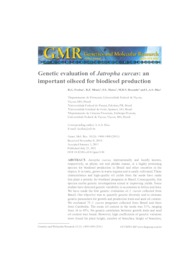Genetic evaluation of Jatropha curcas: an important oilseed for biodiesel production.
Genetic evaluation of Jatropha curcas: an important oilseed for biodiesel production.
Author(s): FREITAS, R. G.; MISSIO, R. F.; MATOS, F. S.; RESENDE, M. D. V. de; DIAS, L. A. S.
Summary: Jatropha curcas, internationally and locally known, respectively, as physic nut and pinhão manso, is a highly promising species for biodiesel production in Brazil and other countries in the tropics. It is rustic, grows in warm regions and is easily cultivated. These characteristics and high-quality oil yields from the seeds have made this plant a priority for biodiesel programs in Brazil. Consequently, this species merits genetic investigations aimed at improving yields. Some studies have detected genetic variability in accessions in Africa and Asia. We have made the first genetic evaluation of J. curcas collected from Brazil. Our objective was to quantify genetic diversity and to estimate genetic parameters for growth and production traits and seed oil content. We evaluated 75 J. curcas progenies collected from Brazil and three from Cambodia. The mean oil content in the seeds was 31%, ranging from 16 to 45%. No genetic correlation between growth traits and seed oil content was found. However, high coefficients of genetic variation were found for plant height, number of branches, height of branches, and stem diameter. The highest individual narrow-sense heritabilities were found for leaf length (0.35) and width (0.34), stem diameter (0.24) and height of branches (0.21). We used a clustering algorithm to genetically identify the closest and most distant progenies, to assist in the development of new cultivars. Geographical diversity did not necessarily represent the genetic diversity among the accessions collected. These results are important for the continuity of breeding programs, aimed at obtaining cultivars with high grain yield and high oil content in seeds.
Publication year: 2011
Types of publication: Journal article
Unit: Embrapa Forestry
Keywords: Clustering, Genetic diversity, Oil content, genetic correlation, heritability
Observation
Some of Embrapa's publications are published as ePub files. To read them, use or download one of the following free software options to your computer or mobile device. Android: Google Play Books; IOS: iBooks; Windows and Linux: Calibre.
Access other publications
Access the Agricultural Research Database (BDPA) to consult Embrapa's full library collection and records.
Visit Embrapa Bookstore to purchase books and other publications sold by Embrapa.

